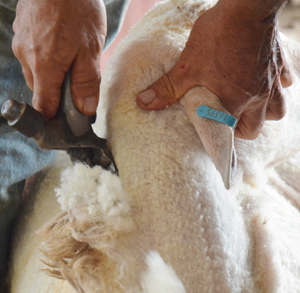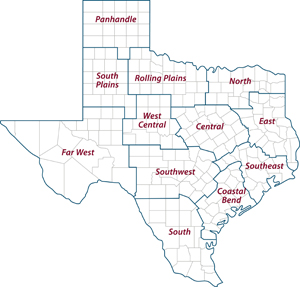by Adam Russell
Markets for goat and sheep meat and fiber continue to be relatively strong despite softening prices and lower inventories, according to a Texas A&M AgriLife Extension Service expert.

Bill Thompson, AgriLife Extension economist, San Angelo, said production data from the sheep and goat fiber and meat markets reveal mixed signals about their place among Texas livestock.
Sheep and goat numbers are down, but prices remain high relative to their respective five-year averages and demand for meat, hair and wool continues to grow.
SHEEP
Sheep inventories are down in the U.S. and in Texas, according to U.S. Department of Agriculture data, as markets for lamb meat and wool continue to perform well, Thompson said. Lamb prices are down slightly, but consumers in traditional ethnic markets and emerging markets continue an upward demand trend.
“Whether you’re talking about chops or ground meat, most large grocers have lamb on hand because of its popularity,” he said.
Wool prices have dipped some since record highs of around $7 per pound in 2018, but remain very strong at more than $6.50 per pound, Thompson said. Production of wool also dipped slightly.
Thompson said the dip in sheep inventories for meat and wool and the subsequent dip in prices are surprising because of price strength and consumer demand.
“We would expect wool production and sheep numbers to come back because wool prices are so strong,” he said. “The decreases are not big, but they are still decreases. You would think the market would take account of the strong prices and grow the production side of the market.”
Thompson said the Rambouillet market dropped significantly, and they were replaced with hair sheep. Labor costs associated with shearing Rambouillets and better parasite tolerance in hair sheep likely contributed to the change, he said.
GOATS
Texas continues to be the top producer of goats by a large margin, Thompson said. Texas’ goat herd as of Jan. 1 was estimated at 740,000 and is larger than the next 10 states combined, which have a total of 631,000 goats.
But the state’s inventory of meat and mohair goats fell 3 percent from 2018, he said. The total U.S. inventory fell 1 percent to just over 2 million animals.
U.S. mohair production was up 2 percent to 755,000 pounds in 2018, Thompson said, with 62 percent of production coming from Texas.
“The goat markets were banner for the last few years, but inventories keep dropping,” Thompson said. “Imports and the value of the dollar may have something to do with that, but there is still room for producers to pencil out pretty good profits.”
One possible deterrent for goat producers, especially those new to the industry, could be the animals’ propensity for escape, property damage and general “mischievousness,” he said.
Predation also continues to be a top concern for sheep and goat producers, Thompson said. Producers south and west of San Angelo have faced challenging losses by incorporating management practices, including the use of guardian dogs.
“It’s been tough, but producers are getting better results with guardian dogs,” he said. “They will have a huge impact on the industry, but it’s just taking time for producers to learn how to train them and use them effectively.”
Despite weakening price trends and lower inventories, Thompson said he expects demand for sheep and goat meat and their respective fibers to continue an upward trend.
“There is high demand for wool and mohair for clothing, especially high-end, high-quality natural fabrics,” he said. “Consumers want natural. They want environmentally friendly and sustainable along with quality. The market for meats continues to grow as well as traditional consumers are wanting more while new consumers are trying those meats and making them trendy.”

AgriLife Extension district reporters compiled the following summaries:
CENTRAL: Conditions were good with adequate moisture. More rainfall was received across the district. Rains hindered plantings by farmers, but some greening was seen in Bermuda grass. Pastures were in good to fair condition with a lot of clover and spring grasses. Wheat continued to look good across the district. Stripe rust was found in many fields, and instances of powdery mildew were also reported. Extremely cold temperatures and hard freezes were in the forecast. Cold temperatures were expected to impact early blooming varieties of this year’s peach crop. Damage to some small-grain crops was expected. Livestock were in good condition. Corn planting began on a limited basis. Stock tanks were full. Nearly all counties reported good soil moisture and good overall rangeland, pasture and crop conditions.
ROLLING PLAINS: Near-record low temperatures and wind chills were reported. Some moisture was received with the cold front. Pastures and rangelands were in poor to fair condition. Calving season was almost complete. Cattle were turned out on winter wheat fields, which were mostly in fair to good condition. Colder conditions and extremely windy conditions made it difficult for farmers to plow and prepare for planting.
COASTAL BEND: Extreme wet conditions halted or delayed most fieldwork. Local row-crop producers were expected to need two to three weeks of dry conditions before fieldwork could resume. Some corn and sorghum fields were planted before rains and colder temperatures arrived. Some corn was planted into shredded cotton stalks. Growers were waiting for warmer conditions before planting cotton. Rangeland and pasture conditions continued to improve but were extremely wet with standing water reported in many areas. Hay producers were fertilizing as soil moisture allowed. Pastures were greening up and full of winter weeds. Hay and supplemental feeding continued. Livestock showed signs of reduced body conditions, but were expected to improve rapidly with the onset of warmer, drier conditions.
EAST: Dreary, wet conditions persisted across the district with more rain in the forecast. Flooding of rivers and lakes continued. Soils were too wet for any activity. Pasture and rangeland conditions were mostly fair to good. Subsoil and topsoil conditions were adequate to surplus. Tractors were getting stuck in many counties. Producers were still running low on or out of hay. Some Anderson County producers were buying corn stalk bales. Ryegrass was greening up. Cherokee County producers were grazing cattle more and slowing down on feeding their herds. Cattle were in fair to good condition. Sale numbers were way down at sale barns in Houston County. Wild pigs continued to cause problems.
SOUTH PLAINS: Subsoil and topsoil moisture levels remained very dry due to lack of moisture and windy conditions. Temperatures dropped, and there was a slight chance of rain in the forecast. Producers were preparing for spring planting. Winter wheat, pastures and rangeland needed moisture. Cattle were in good condition.
PANHANDLE: Much of the district continued to suffer from lack of moisture and drought conditions, although the northwest corner of the district received some moisture. Winter wheat continued to struggle without rain or snowfall events, and some producers were running irrigation systems to help. Producers with wheat fields across the district were deciding whether to continue grazing cattle for gains or to pull them off to grow grain. Producers were top dressing with fertilizer and spraying wheat for weeds where there was moisture. Pre-plant fieldwork for summer crops was underway. Ranchers across the district were supplementing cattle as pastures and cattle conditions declined.
NORTH: Most counties reported adequate to surplus topsoil moisture. Most counties also reported more rain, which hindered fieldwork. Corn was ready for planting, but fields were very saturated. Hay supplies were getting low, and producers were buying hay. Livestock were doing well despite low hay supplies. Wild pig activity was high in some areas. Temperatures were freezing but expected to climb.
FAR WEST: Temperature highs were in the mid-80s with lows around 30 degrees. No recordable precipitation was reported. Very high winds caused topsoil to dry out, and fire danger increased. A hard freeze was expected to have a detrimental effect on planted wheat. Pear and peach trees were blooming, and winter weeds were abundant. Livestock were in good condition. Producers continued to prepare cotton fields. Kidding of lambs and goats was going strong.
WEST CENTRAL: Conditions were warm and dry before turning cold late in the reporting period. Work continued to prepare fields for warm-season crops. Winter wheat was in fair to good condition. Rangeland and pasture conditions improved, but the district needed rain. Demand for cattle was very strong, and sale barns were active. Stocker steers and heifers sold steady and were moved to graze out wheat. Pairs and bred cows were in good demand due to pasture green-up. Feeders were steady and slaughter cows/bulls up $2-$5 per hundredweight. Livestock remained in fair to good condition.
SOUTHEAST: Several counties received additional rains, which were expected to delay the planting of row crops. Pastures and fields were saturated in some areas. Temperatures turned cold in parts of the district. Producers were unable to prepare rice fields for planting due to rain events. Hay supplies were dwindling as winter conditions persisted. Overall pasture conditions were weak due to cool temperatures and saturated soils. Rangeland and pasture ratings were fair to very poor with fair being most common. Soil moisture levels ranged from adequate to surplus with surplus being most common.
SOUTHWEST: A cold front brought freezing temperatures to most counties. Temperatures may set back grasses and trees that were greening up. Foggy mornings and misty days brought traces of precipitation. Planting was expected to be in full swing soon in fields dry enough to plant. Supplemental feeding of livestock continued.
SOUTH: Northern and western parts of the district reported mild weather conditions with short to adequate soil moisture levels. Southern and eastern parts of the district reported cool temperatures and adequate to short moisture levels. Eastern parts reported rainfall. Some counties reported moisture from overcast, foggy, drizzly conditions. Fieldwork continued, but planting was delayed due to the chance of another freeze. Potato planting was completed for the most part, and most planted fields had emerged. Most row-crop producers were expected to halt plantings due to colder temperatures in the forecast. Farmers were preparing fields for crops. Corn and sorghum plantings were active. Oat and wheat fields were in good condition for cattle grazing. Wheat fields continued to progress under irrigation. Pastures and rangelands needed rainfall, and livestock supplementation continued. Coastal Bermuda grass fields were greener. Livestock producers reported some spring green-up on native rangelands and pastures. Supplemental feeding of livestock was reported by most producers. Cotton plantings were expected to begin in the next 10 days. Cabbage and spinach harvests continued. Cattle producers were beginning to think about herd rotation and culling.



